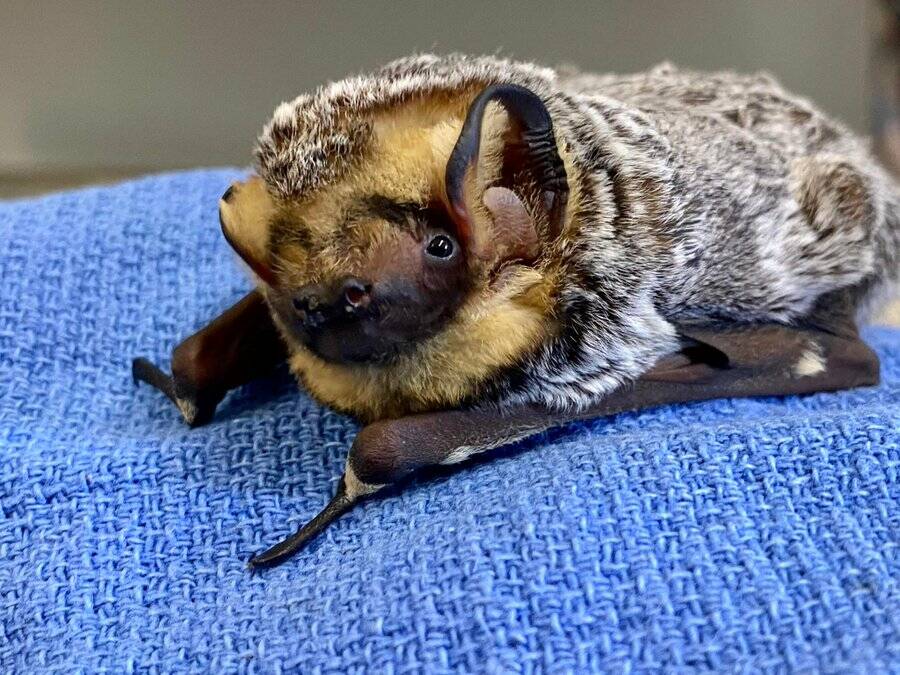By Russel Barsh, Director of Kwiaht.
North America’s largest, most secretive and least understood bats thrive in woodlands on the west side of San Juan Island.
Hoary Bats (Lasiuris cinereus) have been seen flying as far north as the Yukon and hibernating in treetops as far south as the Four Corners. Tagging studies discovered that while some Hoary Bats travel north and south with the seasons, as much as a thousand miles or more others migrate east and west; and some do not migrate at all, forming year-round resident populations.
Gardeners, farmers and foresters should welcome Hoary Bats because they dine primarily on destructive moths, in pursuit of which they fly high above the tree tops at speeds of nearly 20 mph.
Hoary Bats also sometimes prey on some of the large beetles that are pests of orchards and woodlands. Hoary Bats are difficult to study for several reasons. One reason is that they do not form large colonies in conspicuous locations such as caves, barns, bridges or mine shafts. Adult females typically nest alone, somewhere in the treetops—a tree cavity, or simply sheltered by a large branch—where they give birth usually to twins. (Nearly all other North American bats have a single pup each year.) Hoary Bat pups take about five weeks to grow strong enough to fly, but remain with their mothers for several weeks longer as they gain flight experience and learn how to fend for themselves. Yet it is only by a tremendous stroke of luck—or by trapping, acoustic tagging, and tracking individual bats home—that researchers find where a Hoary Bat mother is sleeping with her pups.
Another challenge for researchers—and one of the most intriguing characteristics of Hoary Bats—is that they often fly without echolocating. At the same time, they frequently make low-frequency calls that are completely unlike echolocation chirps. Many insects use sound as well as smell (pheromones) to attract mates; and moths are known to be able to hear ultrasound and eavesdrop on approaching bats. Some moth species even “jam” bat echolocation chirps with squeaks and pops that can confuse attacking bats and throw them off-course. Townsend’s Big-Eared Bats address this tactical challenge by chirping softly (“whispering”) as they approach their prey and going completely silent as they complete their attack. Hoary Bats frequently fly silently to trick their moth prey; this has been blamed for the disproportionately high number of Hoary Bats that have been killed by wind turbines. Hoary Bats on the prowl are flying by dead reckoning and visual cues (such as moonlight) and cannot “see” the propellers as well as bat species that echolocated continuously. At the same time, studies conducted in the past few years have suggested that Hoary Bats talk a lot to each other as they are flying “blind”. Indeed, one study, while based on small numbers of bat recordings and thus not conclusive, raised the possibility that Hoary Bats speak regional dialects, like many birds.
What do Hoary Bats talk about? Food and sex, perhaps; but we really do not yet know. Maybe the study of Hoary Bats on San Juan Island will yield fresh clues. The focal point, for state and local bat researchers, is Lime Kiln State Park. Lime Kiln State Park is surrounded by an extremely rare forest community that is only found in a handful of patches on the west side, near Port Townsend, and lower Vancouver Island. Steep, rocky, and dry, it is rich in Grand Firs and Pacific Madrone (Arbutus to Canadians), with an understory of Alaska Oniongrass, a true grass with a small unpalatable bulb-like root.
Madrones are usually encountered as a pioneer species of dry slopes that grow tall and spindly as they try to compete for light with faster-growing Douglas Firs. Along the west side, however, there are many truly ancient Madrones with multiple trunks growing from a wide ring-like root crown. Over several centuries, the oldest trunks gradually fell as new ones replaced them. Gnarly and scarred by the loss of limbs to windstorms, these stubborn trees afford birds and bats a wealth of sheltered, safe cavities for their nests.
Kwiaht is partnering with Lime Kiln Park staff and Friends of Lime Kiln Society (FOLKS) to monitor Hoary Bats and share this charismatic species with visitors, together with the seven other bat species that make their homes in the park. Contact limekiln@parks.wa.gov (360 378-2044) and info@folkssji.org for events and publications in the summer months ahead!




